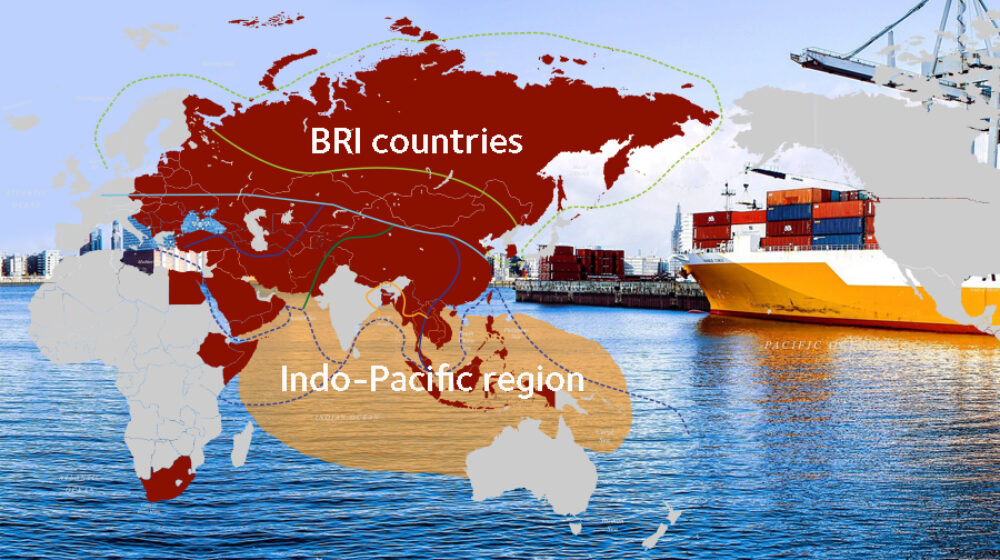Mega-connectivity projects like the China-led Belt and Road Initiative (BRI) might become new templates for economic geographies over time. The BRI encompasses multiple regions (East Asia, Southeast Asia, South Asia, West Asia, Central Asia, East Asia, East Europe, West Europe, South Pacific) and continents (Asia, Africa, Europe and Oceania). If these were eventually connected through land, sea and the cyberspace – as the BRI intends to – the singular identity of the massive economic geography would supersede constituent physical units. The new geography would impact the Indo-Pacific too, given the overlap of maritime spaces between the BRI and the Indo-Pacific.
Geostrategic implications of an overarching economic geography like the BRI are obvious. As a primarily China-funded initiative, it shapes the contours of a China-led pan-regional order. Given the heterogeneity in national economic capabilities and institutional capacities to trade and participate in cross-country production networks in the region, building new infrastructure would have varying degree of success across BRI. This would be a challenge for similarly ambitious connectivity projects like the Asia-Africa Growth Corridor (AAGC) aiming to connect Asia and Africa within the Indo-Pacific.
Connectivity vs strategic autonomy
Funding and project delivery are key challenges to mega-connectivity initiatives. An equal, if not greater, challenge is assuring national and local communities, in countries being connected, about preservation of their strategic autonomy.
The BRI, or the proposed AAGC, are not growth corridors limited to accelerating regional development by linking cross-border economic agents through new infrastructure connecting hubs of economic resources and actors. Their geopolitics is evident from strategic benefits accruing to owners of infrastructure assets. These include control over extractive natural resources like energy and mineral deposits as seen for Chinese state-owned enterprises (SOEs) through BRI projects.
Infrastructure-deficient economies, while hungry for investments, are nonetheless wary over the high price of compromise in strategic autonomy that these investments might entail. Chinese investments under BRI in Pakistan (e.g. China Pakistan Economic Corridor or CPEC) and Sri Lanka (Hambantota port) are pertinent examples. Funding and delivery haven’t been downsides of Chinese investments in these countries. But strategic cost for recipients has been high. The lesson is prominent enough for other connectivity initiatives to avoid similar consequences.
Suspicion over missing economics
The Indo-Pacific lacks a cohesive economic architecture. Notwithstanding multiple regional associations (e.g. APEC, ASEAN, SAARC, BIMSTEC, IORA, SCO) and trade agreements (e.g. CPTPP, ASEAN FTA, SAFTA), there are no ‘Indo-Pacific’ economic institutions or frameworks as such. This is in contrast to APEC or ASEAN that have acquired regional identities from economic programs. It is easier for these organisations to upgrade regional economic agendas to security partnerships by incorporating common concerns flowing out of economic engagement, such as anti-corruption, counter-terrorism, data privacy, money-laundering and transparency.
The BRI also lacks a pan-regional economic architecture. This complicates efforts to connect economically disparate regions. Ambiguity over a core economic framework inevitably diverts attention to geostrategic intentions. The impression of the BRI being an economic project for expanding China’s geostrategic interests strengthens from lack of adequate consultations with regional organisations.
Its implicit unilateral character and pursuit of ‘China-centrality’ is also obvious from non-China regional forums (e.g. SAARC, BIMSTEC) missing mention in its vision statement. In this regard, the BRI is in marked contrast to the Asian Infrastructure Investment Bank (AIIB), which, notwithstanding China being its largest capital contributor, is working as an effective multi-country development finance institution. The biggest testimony to its plurilateral character and rules-based functioning is that India – one of the strongest critics of BRI – is one of the largest borrowers from AIIB.
The must do’s
Humongous economic corridors like the BRI alter economic landscapes of geographies they encompass. But their economic rationale must be backed by clear understanding of institutional and regulatory characteristics of regions and countries they connect. Wider country participations need greater discussions with national and regional associations and agencies. Existing economic agreements can be templates for economic frameworks in new connectivity initiatives in key business issues like customs procedures, investment regulations and environmental standards.
The BRI’s China-centrality is raising concerns over sustenance of funds. At a time when China’s internal debt is rising, the ability of Chinese SOEs to mobilise finances for long-term overseas investment is not assured. This might stall ongoing projects in recipient countries. Mega-connectivity projects can avoid such outcomes by enabling multiple institutions and investors to pick up stakes in upcoming projects. Diversifying the risk profile across countries and institutions is essential for greater credibility of these initiatives. Indo-Pacific connectivity efforts must take note of this necessity.
Dr Amitendu Palit is a Senior Research Fellow and Research Lead (Trade and Economic Policy) at the Institute of South Asian Studies in the National University of Singapore. He can be reached at [email protected] and [email protected]. Usual disclaimers apply.








